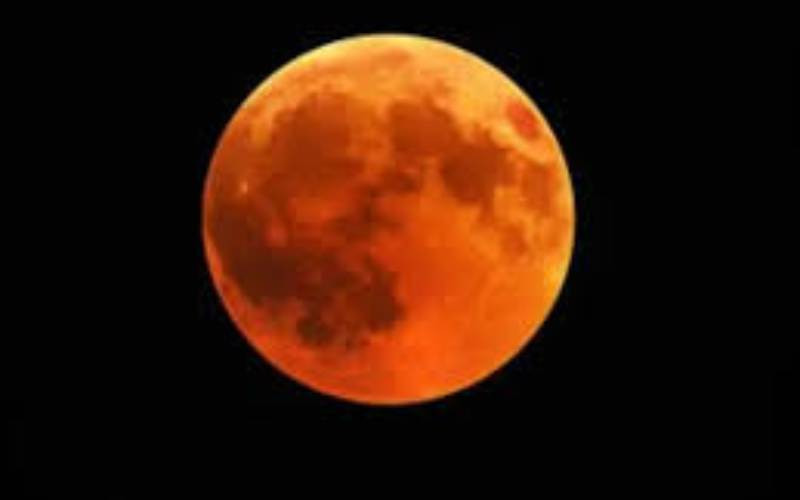Celestial Spectacle: Africa Prepares for Rare Blood Moon Eclipse, Blending Science with Ancient Beliefs!

On Sunday, September 7, 2025, Kenyans and skywatchers across much of Africa and the world were treated to a mesmerizing total lunar eclipse, commonly known as a “Blood Moon.” This spectacular celestial event, where the Moon takes on a deep red or coppery glow, occurs when the Earth passes directly between the Sun and the Moon, casting its shadow across the lunar surface. The distinctive crimson hue is a result of sunlight bending through Earth’s atmosphere, filtering out blue light and leaving the red and orange spectrum.
The eclipse unfolded in four distinct stages. It began with the penumbral eclipse at 6:28 p.m. in Nairobi, a subtle shading as the Moon entered Earth’s outer shadow. This was followed by the partial eclipse at 7:27 p.m., where the Moon progressively darkened from one side. The total eclipse phase commenced at 8:31 p.m., when the bright moonlight vanished, and the Moon began to glow with its deep red hue. The maximum eclipse occurred at 9:12 p.m., lasting approximately 41 minutes, with the Moon sitting entirely in the darkest part of Earth’s shadow. Depending on atmospheric conditions, its glow ranged from vivid red to dusky orange or brownish grey. The total celestial show lasted for more than five hours, with the red moon visible for about one hour and 22 minutes at its peak. Unlike solar eclipses, the Blood Moon is completely safe to view with the naked eye, requiring no special glasses or filters, and was fully visible across Kenya.
Coinciding with this stunning lunar event, Kenya launched its first dedicated astro-tourism experience. The inaugural initiative took place in Samburu County, at Sopa Lodge in Samburu National Reserve, an event graced by Tourism and Wildlife Cabinet Secretary Rebecca Miano. This pioneering move aims to expand Kenya’s tourism catalogue beyond traditional safaris, wildlife, beaches, and cultural tourism. Other locations across the country, including Waterfront in Karen (Nairobi), The Landing in Nanyuki, Ileret Campus of Turkana Basin Institute, and Fort Place Grill in Kabete (Kiambu County), also hosted enthusiasts for the lunar event.
Samburu County stands out as an ideal location for astro-tourism due to its remote and protected environment, boasting some of the darkest skies in the world. Its pristine night skies, minimal light pollution, and clear equatorial skies offer an exceptional experience for observing celestial events, including the Milky Way, constellations, meteor showers, stars, and planets. The unique landscape and cool breeze further enhance this promising experience, attracting astronomy enthusiasts and adventure travelers.
The rise of astro-tourism is fueled by a renewed global interest in celestial wonders. Kenya, strategically located along the equator with pristine skies across several locations and nearly equal night-day hours year-round, is well-positioned to unlock the potential of this new frontier. This diversification is expected to create new jobs for local guides, hospitality workers, and artisans, promote community-led tourism projects that preserve cultural heritage, stimulate investment in infrastructure and environmental conservation, and boost Kenya’s appeal in high-value niche markets for eco-tourists and astronomy enthusiasts.
The astro-tourism catalogue assembled by Magical Kenya features a range of experiences: guided night sky tours with expert astronomers, astrophotography expeditions to capture rare celestial events, educational workshops, and starlit camp experiences. A crucial aspect of this initiative is the integration of indigenous astronomical knowledge from Samburu communities, offering visitors a unique cultural perspective on the stars. Visitors can also combine night sky explorations with daytime wildlife safaris and nature walks, enriching their overall experience.
Beyond its spectacular visual appeal, the lunar eclipse holds significant cultural and scientific importance. Historically, across many groups of people, the event inspired myths and deeply held beliefs. Among the Samburu of Kenya, a lunar eclipse signals an unfavorable period, suspending celebrations until universal balance is restored. The Maasai interpret it as a struggle in the heavens, with communities responding with shaming chants. Along Kenya’s coast, various tribes view eclipses as powerful omens of misfortune, enforcing prohibitions on activities like cooking and childbirth and necessitating ritual cleansing. In West Africa, the Yoruba imagine it as a quarrel between cosmic siblings, requiring prayers and offerings, while the Bambara and Dogon of Mali regard eclipses as profound thresholds through which ancestors offer prophecy and guidance.
In contrast to these ancient interpretations, modern science encourages viewing eclipses with curiosity. Unlike solar eclipses, lunar eclipses pose no harm to the eyes, and no special glasses or filters are required. For scientists, lunar eclipses serve as natural laboratories. By analyzing the sunlight filtered and refracted through Earth’s atmosphere during totality, researchers can detect atmospheric gases, dust content, and pollutants, contributing to climate models. The soft red illumination also highlights lunar surface features, aiding in mapping and understanding lunar composition. Moreover, the precise geometry of eclipses is invaluable for orbital mechanics, allowing astronomers to refine calculations of Earth-Moon distance, orbital tilts, and gravitational forces. Historically, eclipses were crucial for timekeeping, helping ancient civilizations refine calendars and predict future celestial phenomena, with the Saros cycle remaining a foundational predictive tool. Thus, while a total lunar eclipse dazzles as a public spectacle, for scientists, it continues to be a gateway into discovery, revealing secrets about our atmosphere, our nearest neighbor, and the delicate orbital choreography that binds them together.
Recommended Articles
Kenya Gazes Up: Rare Blood Moon Eclipse Ignites Astro-Tourism Boom and Cultural Wonder

Kenya celebrated a spectacular total lunar eclipse, the 'Blood Moon,' on September 7, 2025, which also marked the launch...
African Skies Await: The Mystical Blood Moon 2025 Promising Cultural Wonders & Astro-Tourism Gold

On Sunday, September 7, 2025, Kenya will be at the heart of a total lunar eclipse, famously known as the 'Blood Moon,' w...
Ruto's Reign at Three: President's Legacy Under Fire Amidst Blunders and Shrinking Freedoms

President William Ruto's presidency, initiated after his political upset in August 2022, faces significant challenges de...
Ripple Roars into Africa with New USD-Backed Stablecoin RLUSD

Ripple's USD-backed stablecoin, RLUSD, is now expanding its institutional reach into Africa through partnerships with Ch...
Kenya's Health Scheme in Chaos: Billions at Risk as Flaws Emerge in Crucial SHA System!

The Social Health Authority (SHA) is under scrutiny as a national committee investigates fraud allegations and delayed c...
You may also like...
From Otedola to Ajibade: Love, Legacy, and the Politics of a Name

Temi Otedola has changed her surname to Temi Ajibade after marrying Mr Eazi, sparking a nationwide debate on feminism, l...
Boxing World Erupts! Canelo vs. Crawford Super-Fight Set to Define Legacies

Boxing history is set to be made on September 13 as two pound-for-pound greats, Canelo Alvarez and Terence Crawford, col...
Nigeria's Super Falcons Reign Supreme! Historic 10th WAFCON Title Ignites National Pride
)
Nigeria's Super Falcons clinched their record-extending 10th Women's Africa Cup of Nations title with a dramatic 3-2 com...
Conjuring: Last Rites Dominates Box Office, Unleashing Horror Havoc!

The alleged finale of "The Conjuring" franchise, "Last Rites," has shattered box office records, becoming the highest-gr...
Who Will Be the Next 007? James Bond Speculation Heats Up!

Speculation surrounding the next James Bond is intensifying, with British actor Mike Dickman emerging as a surprise fron...
2025 MTV VMAs Electrifies Audiences: Full List of Performers, Winners & Record Viewership Revealed!

The 2025 MTV Video Music Awards, broadcast for the first time on CBS, achieved record viewership and social media engage...
African Music Royalty Reigns: Burna Boy & Davido Dominate AFRIMA 2025 Nominations!

The All Africa Music Awards (AFRIMA) 2025 nominations have been announced, following a record-breaking 10,717 entries an...
Fatherhood Dream: Pete Davidson and Elsie Hewitt Expecting First Child

Comedian Pete Davidson and model Elsie Hewitt are expecting their first child, a joyful announcement Hewitt made on Inst...